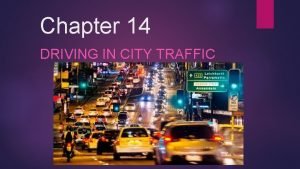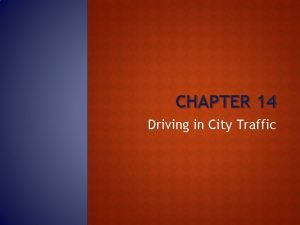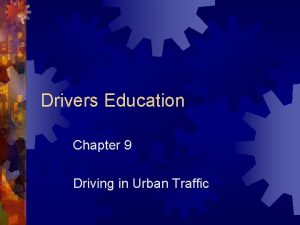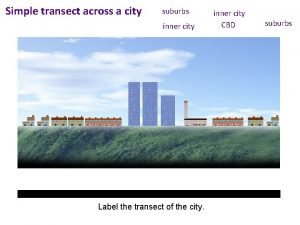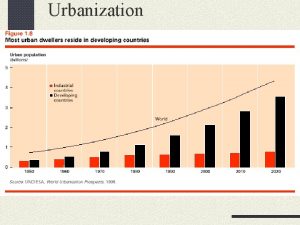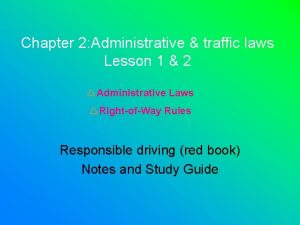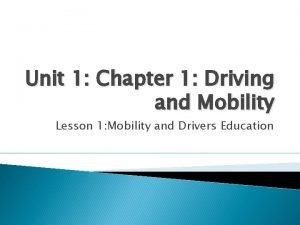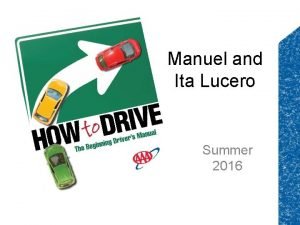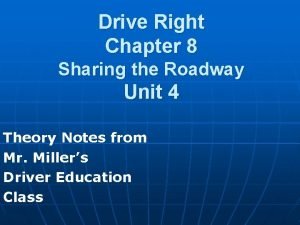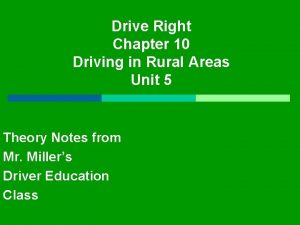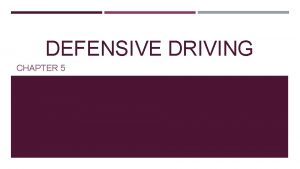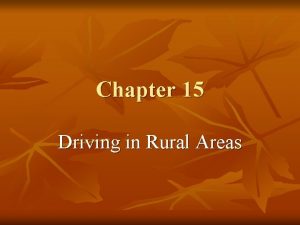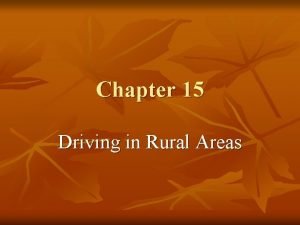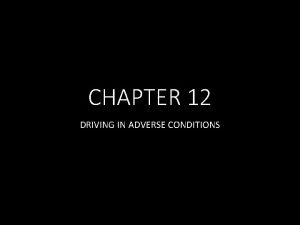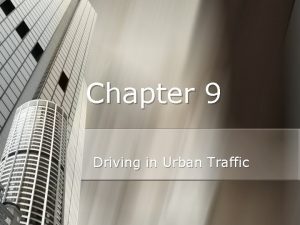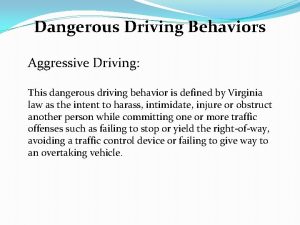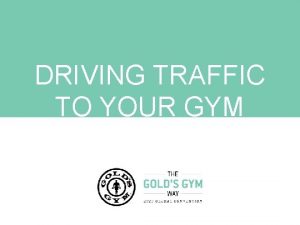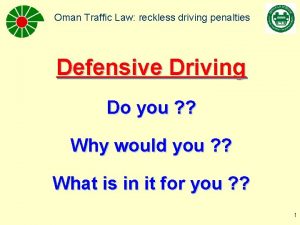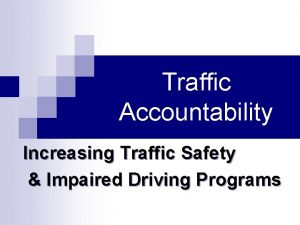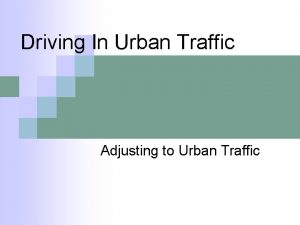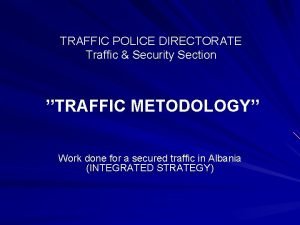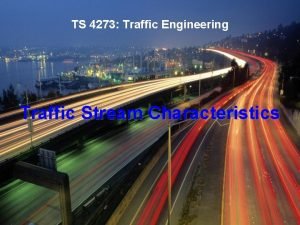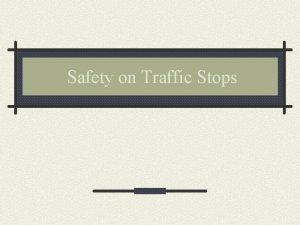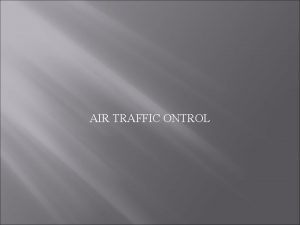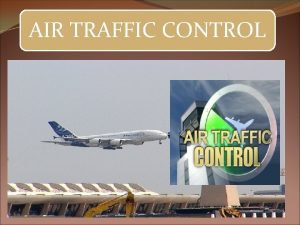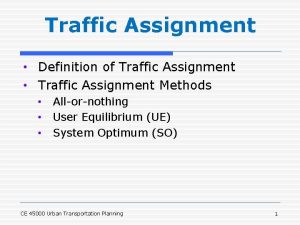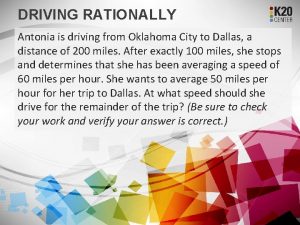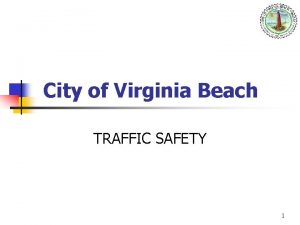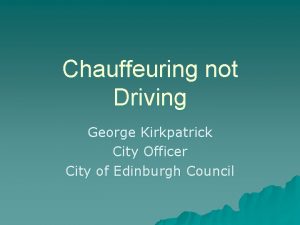CHAPTER 14 Driving in City Traffic This chapter























- Slides: 23

CHAPTER 14 Driving in City Traffic

�This chapter discusses the skills necessary to navigate driving situations in city traffic.

� What are some ways in which city traffic could be different from driving in other areas? � What can we use to reduce the risks presented by city traffic?

� 2 main reasons for city driving being more difficult are: Traffic Density 2. Issues with Time, Distance, and Speed 1.

�Recall of information �You will have 10 seconds to look at the next slide. �After the slide is shown you will be asked to recall the numbers from smallest to largest.

7542 24596 3748472 849494041

�Please write down the numbers. �Did anyone get: �The 1 st set? � 1 st and 2 nd set? � 1 st, 2 nd, and 3 rd set? �All 4 sets? �Why was this difficult? �This time you will see four numbers. How many times does the number 4 appear?

7542 24596 3748472 849494041

�How many times does the number 4 appear? �Is it easier to pick out specific items if you know what you are looking for?

� Identify �Be aware of aggressive drivers and distracted drivers � Predict �Possible points of conflict to gain time to respond � Decide �Change speed and communicate to create time and space � Execute �Carry out you decision in a smooth deliberate manner

� How far behind another vehicle should we be (in terms of time)? � How do you check your following distance? � 3 Second Rule

� What might be some situations in which you would need to increase your following distance to more than 3 seconds? �Beginning driver �Being tailgated �Approaching a LOS restriction �Any poor traction setting �Heavy load/vehicle �Driver ahead seems unsure �Following a motorcycle

� Define Tailgating. �Following someone too closely (less than a 3 second following distance) � Managing �Increase a tailgater your following distance to 4 sec. or more. �Move slightly to the right. �Signal early for turns and stops. �Change lanes or pull over and let them go by.

� How far ahead of your path of travel should you be looking? �½ - 1 block in heavy traffic in a city setting

� Search your target area to find traffic signals. � Red light �Slow � Green and prepare to stop. light �“Fresh” �“Stale” Cover the Brake � What else at the intersection could help you determine if the light is “stale” or not?

� Scan Sidewalk to sidewalk � Identify signs, signals, and roadway markings � Be aware of the roadway features and conditions � Identify the other users � Identify intersections and driveways so you know where traffic can come from

� Cover the brake � Look for drivers inside the car (through windows) � Pay attention to: �Tail lights �Presence of exhaust (cold weather) �Front wheel position � Be prepared to change lane position to the left � Video

� What should you do if an oncoming car enters your lane? How would you avoid a collision? �Slow Down �Steer Right �Honk horn �Flash Lights � Video Demo

� 4 simple questions: �Which one is the safest? �Am I going to keep going straight? �Am I going to turn left? �Am I going to turn right?

� What can help you identify if the cross street is one-way or two-way? �Parked cars �Lane markings �Traffic flow �Signs

� Always turn from the closest lane available to the turn into the first available lane in your direction.

� Treat same as if the crossed the center line. �Steer right �Slow down �Honk �Flash lights

Explain what are the two main factors that increase the difficulty of driving in urban settings. � Explain four ways to help you manage tailgaters. � Explain what to do to avoid a collision with an oncoming vehicle in your lane. � Explain how far ahead should you be scanning in an urban setting. � Explain what can you do to help you avoid a possible hazard ahead of you on your side of the road. � List 3 of the 5 items you should be looking for when driving in an urban setting. � Explain how you select which lane you should be in when driving on a multiple lane road. � Explain which lane do you turn into when turning onto a cross street. �
 Chapter 14 driving in city traffic
Chapter 14 driving in city traffic Why is city driving more difficult
Why is city driving more difficult A guide for selecting the best driving speed is to
A guide for selecting the best driving speed is to Incomina
Incomina All traffic solutions
All traffic solutions City traffic plugin
City traffic plugin While driving in the city the busy urban
While driving in the city the busy urban How can you best use the ipde process in city driving
How can you best use the ipde process in city driving Latin american coty model
Latin american coty model Hoyt model
Hoyt model Primate cities
Primate cities Administrative vs traffic laws
Administrative vs traffic laws Administrative laws driving
Administrative laws driving Chapter 2 administrative and traffic laws
Chapter 2 administrative and traffic laws How is the hts regulated
How is the hts regulated Chapter 1 managing risk when driving
Chapter 1 managing risk when driving What is velocitation
What is velocitation Alcohol is the most commonly used drug in our society
Alcohol is the most commonly used drug in our society A motorcyclist's balance and stability depend on
A motorcyclist's balance and stability depend on Drive right chapter 10
Drive right chapter 10 Chapter 5 defensive driving quiz answers
Chapter 5 defensive driving quiz answers Chapter 15 driving in rural areas
Chapter 15 driving in rural areas Chapter 15 driving in rural areas
Chapter 15 driving in rural areas Driving in adverse conditions
Driving in adverse conditions
